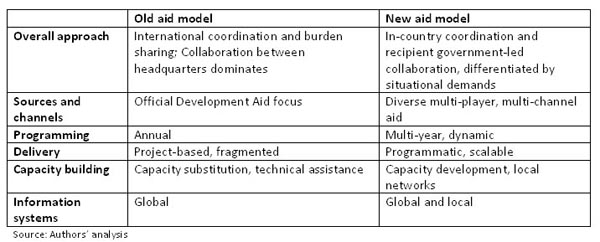We live in a new reality of aid. Rich countries delivered $3.2 trillion of aid to poor countries between 1960 and 2008; and today, aid is a $200 billion industry. Despite disputes and upheavals, the core of the aid industry has changed little over the past few decades. Now the new pressures on the aid system may be too strong to resist fundamental change.
Delivering Aid Differently
(Brookings Press, 2010) has been written at a time when the future of foreign aid is being fiercely debated. On the one hand, aid experts, including Peter Singer and Jeffrey Sachs, support a huge increase in the size of foreign aid budgets, faulting a lack-of-donor generosity for the continued existence of severe poverty. Their message: aid works; we just don’t do enough of it.
On the other hand, in scathing critiques of aid, William Easterly and Dambisa Moyo argue that by detaching recipient governments from accountability to their citizens, aid has retarded the progress of poor countries. In between these camps, aid practitioners argue that foreign aid could work if only it were done right. What should we believe when there is such disagreement among experts? If development aid was really so ineffectual why has it increased so rapidly over the last decade? Why have so many new actors joined in giving aid, including countries like Singapore which is extremely determined to use its resources efficiently?
While all sides have some good arguments, we believe that the developments of the last decade have radically reshaped the aid architecture and traditional arguments no longer hold. Today, the main paradox of aid is that despite increasing flows and more players, aid has declined in relative importance in most countries. This new aid architecture is characterized by three important shifts:
First, strong growth in many developing countries, including in Africa since 2000, has redefined aid. Many countries, especially in East Asia, have fulfilled the dream of development aid: to make it nearly obsolete. For many years, foreign direct investment has exceeded aid by a wide margin. Demand for aid from developing countries is now increasingly differentiated. Gone is the “Third World” as a homogenous block of poor countries in the South. Many previously poor countries, largely in Asia, have been growing richer and have become major donors themselves.
Second, the donor landscape has changed fundamentally over the last decade, a trend that will likely accelerate in the coming years. New players—international NGOs, foundations and private corporations—are responsible for an ever larger share of aid volumes. Private philanthropy from developed to developing countries now tops $60 billion annually.
These new players have brought fresh energy and approaches to the delivery of aid but while the volumes of aid are growing, the average project size, even for traditional donors, is shrinking. Small projects can deliver benefits to isolated communities but they also increase aid fragmentation that multiplies administrative costs and complicates donor coordination by recipient governments. In 2007, for example, official donors sent more than 30,000 missions to manage their aid projects. With weak monitoring, successful projects can go unnoticed and can’t be replicated or scaled up.
Third, innovation, especially in information technology, has started to reshape development aid. Knowledge transfer has become as important as financial aid, but combining the two can be remarkably transformative. We believe that information, the hardest currency in the 21st century, ought to be at the center of aid delivery models. Recipient countries could champion a “single-window” approach to aid regulation, reducing the confusion and inefficiency of current delivery methods. These one-stop information exchanges would more readily point up the comparative advantage of different providers and make known what each player is doing.
A transparent coordination strategy, such as this one, can achieve the key goals of scalability of projects, predictability of aid flows, efficient division of labor, and low transaction costs. It will bring better geographic division of labor and open up the possibility for competition between aid agencies—a potentially powerful driver of efficiency. Such a dynamic model of development would be more effective at generating knowledge and channeling it into national systems.
Capacity building needs to be rethought in the same way. The old model of flying-in overseas experts to dispense policy prescriptions should be replaced by a continuous knowledge exchange that makes the best use of local talents. Africa can also learn from those who have successfully managed economic transitions in the South.
Aid can work, but it needs to be delivered differently to create lasting impact in the 21st century (see table below). A new consensus can be built around the ideals of information openness and decentralization of coordination efforts. Networks of aid coordinators and aid agencies would share information around the world, driven by common standards for data management. With these improvements, money that is intended to help the poor will reach them in more efficient and fairer ways, and it will help deliver greater development results.

The Brookings Institution is committed to quality, independence, and impact.
We are supported by a diverse array of funders. In line with our values and policies, each Brookings publication represents the sole views of its author(s).



Commentary
A New Aid Model for the 21st Century
November 15, 2010